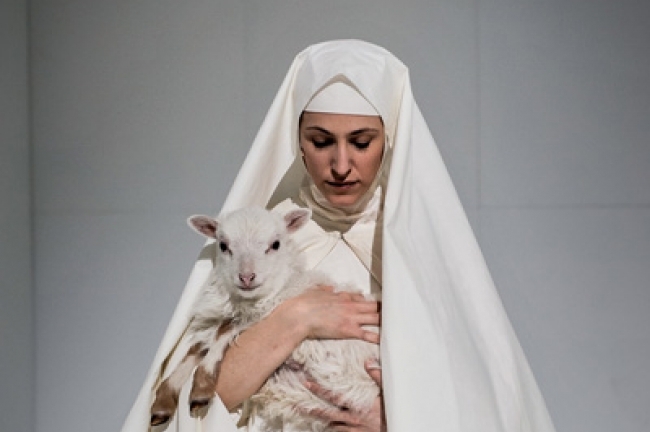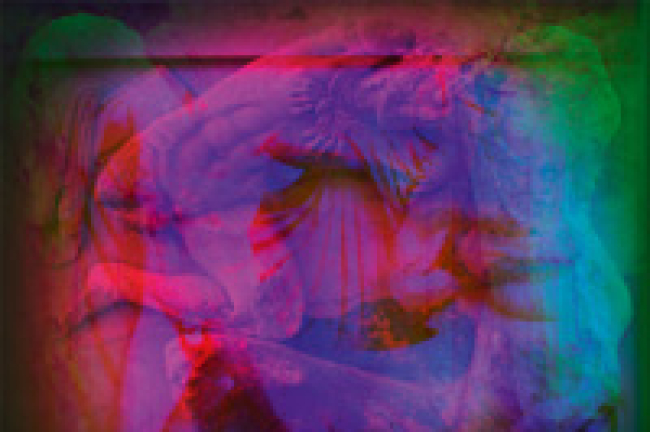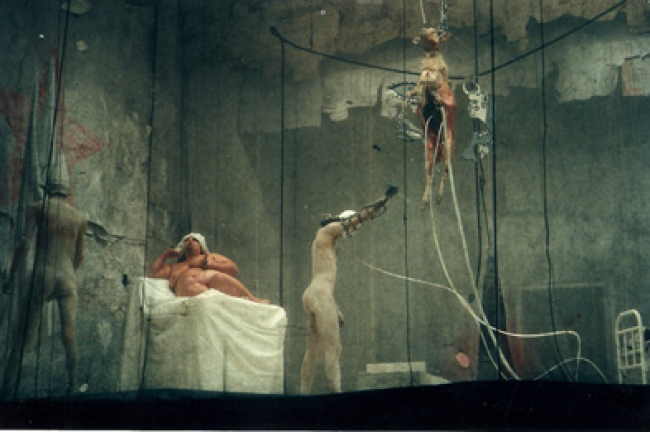Romeo Castellucci’s second Parisian autumn will be a Greek one. Whether “Biblical” or “Greek”, the Italian director has been unceasing in his efforts to bring back to the surface the founding gestures of our culture, written and non-written, in order to reactivate them and put them to the test of our present. The immediate historical referents for each of the three pieces to be presented this season are very definitely Greek: Orestie (une comédie organique?); Ödipus der Tyrann; and Le Metope del Partenone. Together they fit into the narrow, dizzying, spatio-temporal window of Pericles and his century. Indeed, Phidias and his team sculpted the Parthenon friezes in between the period of time when, on the flanks of the Athenian hillside, Aeschylus brought us the Oresteia (458), in the theatre of Dionysus, and Sophocles Oedipus Rex (around 420). Key events, then, in the midst of an era during which the city-state par excellence invented this new art form: tragedy.
The question of tragedy, its impossibility - in the Greek sense - and the need to face it in order for it be investigated has frequently come back to haunt the author of Go Down, Moses. When he embarked on the Tragedia Endogonidia (2002-2004), and its eleven episodes anchored in ten European cities, Castellucci indicated that: “Going back to tragedy does not signify a return to the past. It is more a question of cutting - and not picking up - the thread of Aeschylus. Tragedy ought to be considered as the only worthwhile competitor against which we can measure ourselves” (1). With Orestie (une comédie organique?), which he has decided to put on again, repertory-style, in its original version, twenty years after it was first performed, the director had already “cut the thread of Aeschylus”, becoming a sort of liberated “son” of the Oresteia. Exercising his right to shake the very foundations of this text, fragmenting them and exposing them to the present, via present-day means, namely those of technology and contemporary art, notably in the references to Bacon, was the director’s way of recalling the famous Triptych inspired by Aeschylus’s Oresteia.
Just as Aeschylus and Sophocles extracted material for literary works of their own from heroic legends, so too has Castellucci delved into the Oresteia and Oedipus Rex for the making of his stage-work. He is not, however, alone in his efforts. In Ödipus der Tyrann, he has enlisted the guiding light of Hölderlin’s translation. For Castellucci, the German poet’s translation, along with its title, is the only one to have conveyed Sophocles’ text at its deepest level. It prompted the director to present, for the very first time, a piece written in its continuity. This new approach, however, has not prevented him from linking his Oedipus with his previous works. In episode P.#06 Paris of the Tragedia Endogonidia, performed in 2003 at the Odéon-Théâtre de l’Europe in conjunction with the Festival d’Automne, we saw the furtive entry, through a window, of a (masculine) Jesus/Oedipus, and who very definitely paid his dues to the Sphinx. In Ödipus der Tyrann, we will be to witness to his (female) avatar, Oedipus/Jesus, seemingly replying to him from his Theban palace.
Numerous figures travel in such a way from one work to the next. It would impossible not to evoke the references to Bacon, inciting us to us look again at the images found in Orestie (une comédie organique?) and Ödipus der Tyrann. This composition brings us back to the question of colours and the colour of the flesh in Bacon’s work, a subject matter which Deleuze held close to his heart. The words of the philosopher, “Every man who suffers is a piece of meat” (2) echo the appalling accidents that the director summons up in Le Metope del Partenone. Even though the catastrophes are, repeatedly so, a far cry indeed from tragedy, Castellucci does all he can to shift around any immediate significations they might have, by means of a sharp twist in the proceedings, unleashing a series of written “riddles” just as the action unfurls.
Last year, Go Down, Moses presented us with a few examples of these enigma. Such a form is one that Vernant links directly to the development of what may be called a tragic consciousness. “Man and his actions were presented, in tragedy’s peculiar perspective, not as stable realities that could be placed, defined and judged, but as problems, unanswerable questions, riddles, whose double meanings remain enigmatic however often decoded.” (3) This is where Castellucci’s theatre comes into competition with tragedy - in the search for a theatre for our century. A theatre which is unmistakably tragic, and radical, in that it prompts us to reconsider the place of the audience. This gesture alone, as tenuous as it might be, is very much in the order of tragedy, in that questions the individual and adds or restores, via a dotted line, a contour to a potential city-state.



